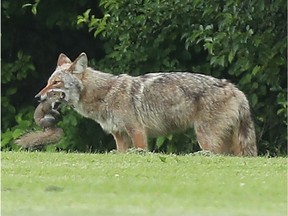Wednesday, April 17: Bear hauling, beaver cull: Readers have strong opinions on the city’s next wildlife strategy. You can write to us at [email protected]

Article content
We can coexist with wild animals.
Re: Will Ottawa take a humane approach to urban wildlife? We are skeptical, April 10.
Article content
It is shameful that the country’s capital continues to kill wildlife. Other cities introduced “wildlife and coexistence” programs years ago. These cities have developed a wide range of other environmentally progressive initiatives, such as sponge parks and rain gardens, wildlife passage guidelines, and biodiversity strategies.
Advertisement 2
Article content
Why is Ottawa so far behind? From the good work being done in other cities, it seems to come down to vision, leadership and, most importantly, the willingness of staff to involve the public in the solutions. The Citizen’s op-ed about Ottawa excluding groups from the Wildlife Strategy consultation process should send a strong message to the mayor and councilors about what needs to change.
Kristiina Musson, Kanata
The wildlife plan is a Pandora’s box
Human interactions with wildlife are complicated. Some people ask that the bears be transported to other locations. Others are upset that some species have been transported into their neighborhood. Some express concern about beaver euthanasia. On the other hand, anyone with a rat or mouse infestation will take steps to cull these pests.
Ottawa has a large agricultural community. There are some organic farmers. However, most farmers rely on the use of pesticides (insecticides, herbicides, rodicides, etc.) to produce the foods we enjoy. All of this is to say that a wildlife plan is very complicated and can involve treating different species differently and different situations differently.
Advertisement 3
Article content
The city has much more important and urgent things to do than open Pandora’s box of a wildlife plan. It is best to limit the city’s role to helping residents better deal with their interactions with our wildlife. This could involve how to make your residence mouse or raccoon proof. Another is advice on how to eliminate stagnant water, where mosquitoes spread.
Alan Asselstine, Ottawa
Bad management wastes our money
For a city facing serious financial challenges, it’s disturbing to hear how money is being wasted on Ottawa’s outdated approach to beaver management.
Spending hundreds of thousands of dollars a year to physically maintain the enormous number of sewers and stormwater ponds on city roads is unacceptable when a proven alternative exists. It involves installing flow devices that effectively protect infrastructure while allowing beavers to continue providing their essential environmental services.
Flow device technology would eliminate or greatly reduce costs to Ottawa taxpayers, while benefiting the environment and providing a humane alternative to beaver culls. Verify www.beaverinstitute.org for modern solutions.
Advertisement 4
Article content
Robert McNamara, Stittsville
Beaver culls must end
I was surprised to learn that the city of Ottawa kills 150 beavers a year. Cities across North America are recognizing that beavers are a critical ally in protecting our shrinking wetlands, a key component in the fight against climate change. Several US states, facing floods, droughts and wildfires, are reintroducing beavers.
How can Ottawa have declared a climate emergency and not be aware of this fact?
It seems that the bureaucracy is content to move forward in isolation, out of step with the rest of the universe. Where is our elected leadership?
Eric Farrar, Ottawa
Recommended by Editorial
-

Today’s letters: Mayor Sutcliffe’s marathon tourism effort deserves applause
-

Today’s letters: Canada’s military must cultivate public pride
Article content


